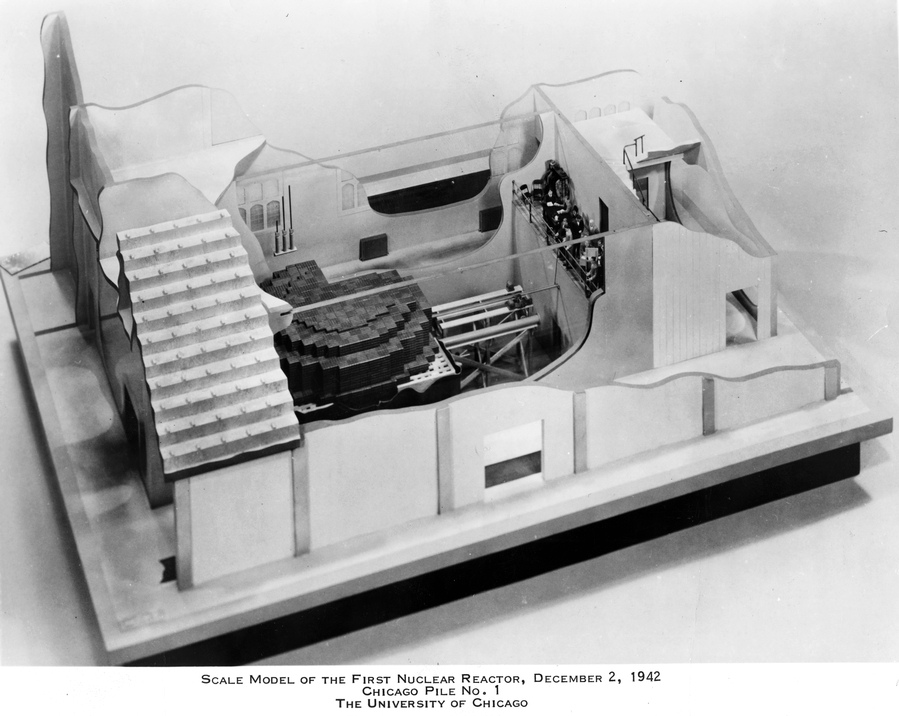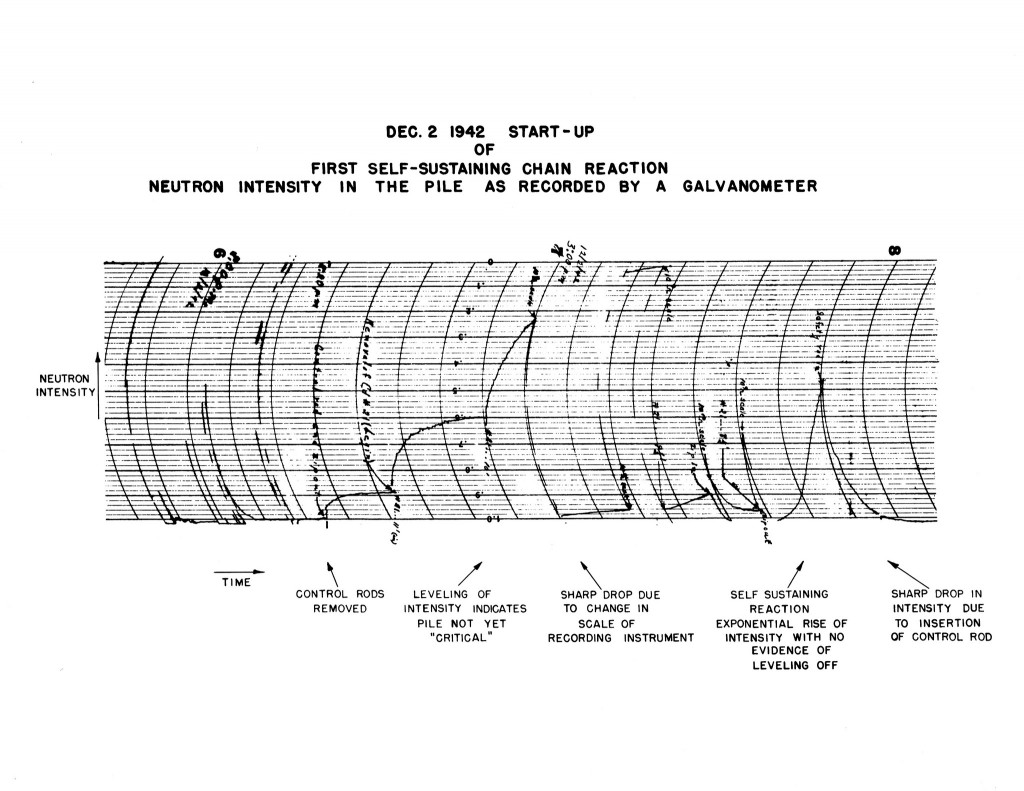"A New and Important Source of Energy" - CP-1 at 75 years
"Some recent work by E. Fermi and L. Szilard, which has been communicated to me in manuscript, leads me to expect that the element Uranium may be turned into a new and important source of energy in the immediate future." - Albert Einstein, letter to President Franklin D. Roosevelt, August 2, 1939
Over three quarters of a century have passed since the first attempt to harness the energy of the atom. While it was Einstein's letter to President Roosevelt that spurred what would become the enormous, almost crash-speed Manhattan Project, it was the narrower group of experts led by Enrico Fermi who, on December 2, 1942, would operate for the first time the atomic pile they had spent a month building and years preparing for.

Photograph of scale model of CP-1, the first atomic pile. Provided courtesy Argonne National Laboratory.
The Pile-so named because of its actual construction from roughly 385 tons of graphite bricks, interspersed with fuel-bearing layers holding uranium and uranium oxide-was constructed under disused spectator stands at Stagg Field, University of Chicago. Walter Zinn, later to become the first president of the American Nuclear Society upon its formation, led the team under that stands that actually machined the graphite blocks for constructing the pile. According to Albert Wattenberg, who worked for Zinn, the group "found out how coal miners feel" because of the intensive graphite dust.
Quite separately from this effort, there had already elsewhere been, by the estimation of Fermi himself, no fewer than 30 piles already built as tests or experiments leading to this effort. All were subcritical, but essential to compiling the necessary data that comprised the steep learning curve that Fermi and his team were still climbing.
The Pile, which would retroactively be called CP-1 ("Chicago Pile 1", a label not required until there was a "Pile 2") was in a very real way being designed as it was being built-and, unsurprisingly, plans changed as the construction went on. "Critical conditions were achieved somewhat sooner than anticipated," according to the entry in the historic Atomic Energy Deskbook, "so that the reactor assembly, which had been expected to be spherical, took the shape of an obloid spheroid somewhat flattened at the top." However, it was not as if the process was all that cavalier or random. Fermi was constantly recalculating the critical condition of the pile as it was built (and thus reconfigured) and, according to "The First Reactor," Fermi was able to predict days before the actual December 2 test that the reactor was nearly at a critical configuration.
This pile did have moving parts-cadmium control rods. A "Zip" emergency control rod was in the reactor, vertically. It needed to be fully withdrawn for the reactor to achieve a chain reaction. There was also what the scientists coined a "Vernier control rod" used to bring the reactor carefully to criticality. This was manually operated from the side. Another set of rods was operated electrically, remotely from the balcony. Further, a "liquid control squad" was ready to douse the pile with a cadmium-salt solution as an emergency shutdown measure. There was neither shielding nor cooling, the pile quite literally was just that.
Finally on the afternoon of December 2, the moment arrived that would indeed change the world in many ways-the first man-made atomic chain reaction. And it had to wait for lunch. The morning run, originally intended to be the successful one, took quite long and ended with an automatic rod trip caused by the trip signal having been set too low. The afternoon session proved to be the successful one:
"The intensity shown by the indicators began to rise at a slow but ever-increasing rate. At this moment we knew that the self-sustaining reaction was underway." (Words of Enrico Fermi, US AEC booklet "The First Reactor.")
There was no cheer, no photo session (although there was a bottle of wine). In fact, it was not until 1946 that professional sketches of the appearance of the finished reactor and control balcony were actually made, from the memories of those present. This project was so secret that not even Laura Fermi, Enrico's wife, was let in on it until years later. Implying the success without stating it, Arthur Compton telephoned James B. Conant at Harvard University and said dryly that "the Italian navigator has landed in the New World."

Actual neutron detector trace as recorded during afternoon of December 2, 1942 and the first criticality of CP-1. Courtesy Argonne National Laboratory.
Events after this important day moved even more rapidly. After being operated just a few more times, the pile was dismantled, redesigned, and rebuilt at a new location as CP-2. The men and woman involved (for there was one woman, physicist Leona Woods, present at the actual startup) dispersed to pursue separate but important goals. A larger pile was built at the Clinton Laboratory (later known as the Oak Ridge National Laboratory) and much more information about the operation of piles (later all known as reactors) was obtained. The war effort dictated the use of the knowledge to that end until cessation of hostilities, but the scientists of Oak Ridge, Tenn., were thinking about and sketching a power producing atomic reactor as soon as the war was ended. The great enterprise of atomic energy was underway.
Sources:
"The Atomic Energy Deskbook." John F. Hogerton. Reinhold Publishing Corporation, New York, 1963.
"The First Reactor." US Atomic Energy Commission, undated.
Will Davis is a member of the Board of Directors for the N/S Savannah Association, Inc. He is a consultant to the Global America Business Institute, a contributing author for Fuel Cycle Week, and he writes his own popular blog Atomic Power Review. Davis is also a consultant and writer for the American Nuclear Society, and serves on the ANS Communications Committee and the Book Publishing Committee. He is a former U.S. Navy reactor operator and served on SSBN-641, USS Simon Bolivar. His popular Twitter account is @atomicnews.

